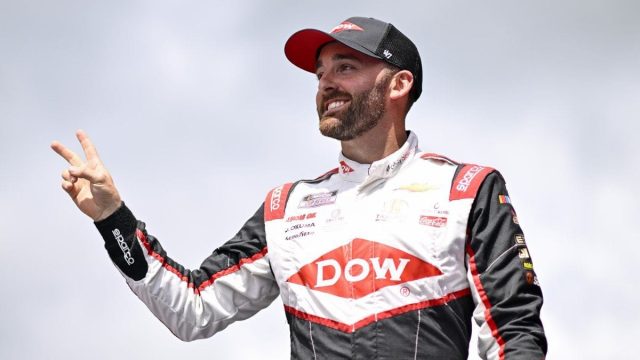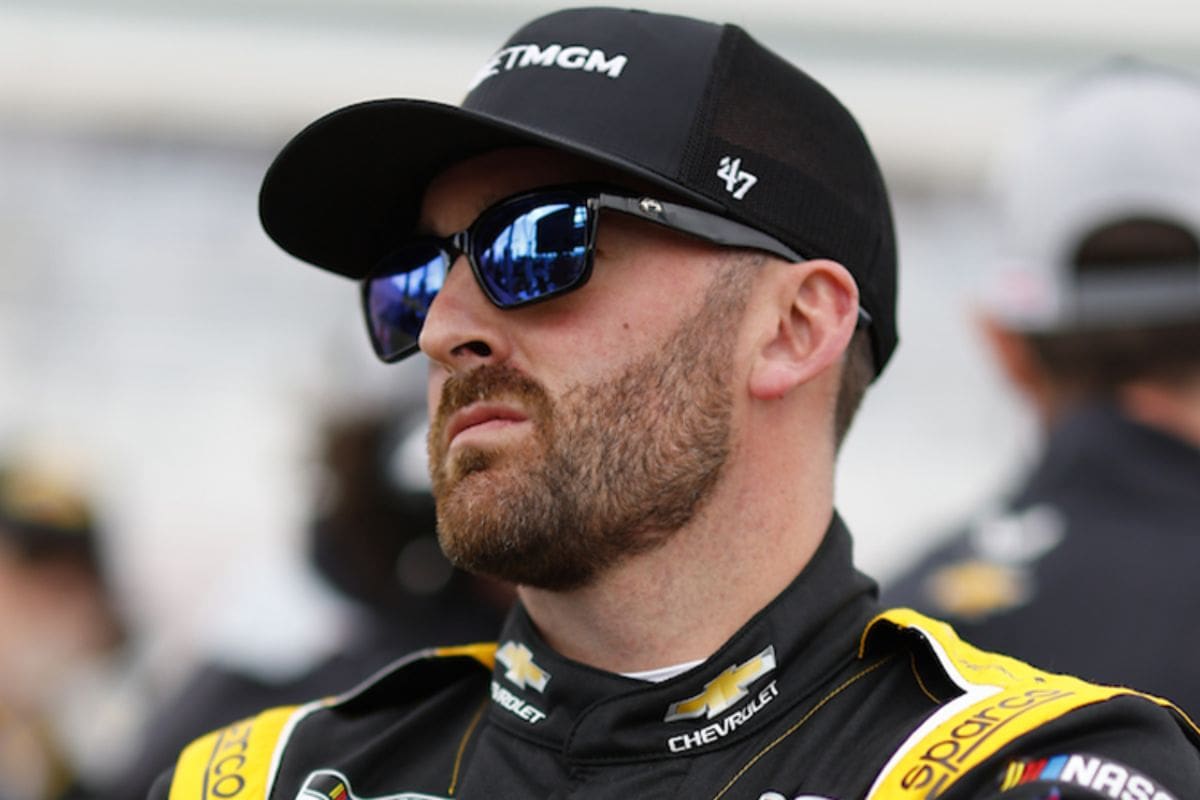Austin Dillon Enters Into Villain Arc: Austin Dillon‘s recent adoption of a villainous persona of Denny Hamlin has sparked a notable reaction within the NASCAR community, transforming him into a central figure of intrigue and debate. This evolution cultivates intense rivalries and builds a unique fellowship among fans, who are actively engaging through social media and merchandise. As Dillon navigates the complexities of his newfound identity, the implications for both his career and the broader NASCAR landscape invite further examination. What does this shift mean for the sport’s future dynamics and the nature of fandom itself?
Key Highlights
- Austin Dillon’s embrace of a villain persona, inspired by Denny Hamlin, has sparked enthusiasm and mixed reactions among NASCAR fans.
- His aggressive racing tactics and competitive spirit resonate with fans, leading to increased engagement on social media and heightened interest in NASCAR.
- Dillon’s acknowledgment of his villain role during pre-race events reflects a deeper understanding of racing dynamics and fan expectations.
- The incident has resulted in a surge in merchandise sales and community events, showcasing a strengthened NASCAR fanbase and shared experiences.
- Denny Hamlin’s influence on Dillon has fostered camaraderie within the NASCAR community, highlighting the importance of mentorship and collaboration among drivers.
Austin Dillon’s Villain Arc: The Comparison to Kid Rock
Austin Dillon’s recent entry into the role of a racing villain draws intriguing parallels to the music and persona of Kid Rock, illustrating the complexities of public perception in sports. Both figures exist in a space where admiration and disdain coexist, often eliciting polarized reactions from their audiences. Dillon’s admission, “I got half the country that hates me and half the country that loves me,” resonates with Kid Rock’s career, which has likewise sparked loyalty alongside vocal criticism.
In the past week, Dillon has thrust himself into the spotlight by taking out prominent drivers like Joey Logano and Denny Hamlin, actions that echo the aggressive tactics often attributed to controversial figures in racing. Such moves have led fans to speculate that Dillon is embracing a “villain arc,” akin to Hamlin’s own tumultuous relationship with the fanbase.
This calculated positioning within the NASCAR narrative invites viewers to reflect on the role of antagonism in sports, where the line between hero and villain can be remarkably thin. Dillon’s strategy of channeling past rivalries not only heightens competitive tension but also engages the audience in a broader conversation about identity and legacy within racing.
Just as Kid Rock has utilized his contentious persona to cultivate a unique brand, Dillon is redefining his own narrative through provocative actions. As NASCAR fandom swirls with excitement and dissent, the question remains: is Dillon’s villainy a mere phase, or could it signify a deeper evolution in his racing career?
Dillon Owning It Like Hamlin?
In the domain of NASCAR, where rivalries often define careers, Dillon appears to be accepting his role with a confidence echoing Denny Hamlin‘s own notorious moments on the track. Much like Hamlin’s bold tactics at Pocono, which cemented his reputation as NASCAR’s black hat, Dillon’s recent actions in the Cook Out 400 have sparked a similar wave of controversy. By employing aggressive strategies to secure his victory, Dillon not only faced repercussions—such as losing playoff eligibility and points—but also found himself in the eye of a storm of fan discontent.
What distinguishes Dillon in this scenario is his unabashed acknowledgment of the villain role. During the pre-race introductions at Michigan, he leaned into the animosity, waving and blowing kisses to a crowd that showered him with boos. This audacious display mirrors Hamlin’s own acceptance of the villain narrative, particularly after his success at Bristol, where he welcomed the jeers as a badge of honor.
Dillon’s actions suggest a calculated strategy: owning the backlash while simultaneously positioning himself as a figure of intrigue in the NASCAR landscape. In a sport often characterized by its heroes and anti-heroes, Dillon’s willingness to channel Hamlin’s approach reveals a deeper understanding of the dynamics at play.
Dillon’s Perspective on the Penalty
A notable moment of introspection emerged for Dillon following the hefty penalty imposed on his team, yet he displayed a steadfast stance, reflecting a broader philosophy shared by seasoned competitors like Denny Hamlin and Joey Logano. Rather than wallowing in regret, Dillon articulated a mindset that characterizes the competitive spirit of NASCAR: “This is a game. In the end, you don’t hate the player, you hate the game.” His perspective emphasizes a fundamental truth in motorsport—decisions made on the track are often dictated by the relentless pursuit of victory.
This is a game. In the end, you don’t hate the player, you hate the game. That was the situation that I was up against. I’ve learned a lot from Joey and Denny over the years. They don’t have any regrets in what they do on the racetrack. I can’t either and I don’t feel that way.”-(dillon)
Despite the implications of his actions on fellow driver Hamlin, who has publicly praised Dillon, the latter remains undeterred by the penalty’s weight. Dillon’s admiration for Hamlin and Logano is evident; he recognizes their ability to navigate the complexities of racing without remorse, embracing the inherent risks involved.
“We’re still going to push the edge to try to get the guy out of the groove to win the race, we’re still going to make contact, I think there’s a balance of entertainment and sport that can be had here. It’s just a matter that’s one where you really need to put your foot down and say we’ve got to police the sporting aspect of this at that point.”-(dillon)
Hamlin’s own comments regarding the penalty reveal the intricate balance between entertainment and the integrity of competition. He suggests that the ‘win-and-you-are-in’ format has transformed the landscape of NASCAR, prompting drivers to push boundaries.
Dillon’s acceptance of this reality, coupled with his refusal to dwell on missteps, demonstrates a commitment to the sport’s evolving narrative. In this light, his perspective transcends the immediate consequences of the penalty, embracing the necessity for adaptation in an unforgiving arena.
NASCAR Fans’ Reaction: Villain Status for Dillon?
While the NASCAR community has yet to officially designate Austin Dillon as the sport’s next villain, fan sentiment suggests a growing perception of his emerging role in this narrative. The recent discussions surrounding Dillon’s antics and competitive spirit have sparked a lively debate among fans, particularly in the wake of Denny Hamlin’s waning villain status.
Dillon’s attempts to channel Hamlin’s audacity have not gone unnoticed, as evidenced by diverse fan reactions on social media. Some believe Dillon is actively trying to step into the villain role, while others speculate whether he can rival Hamlin’s notorious reputation.
“He tryna be the next NASCAR villain.”
“Bigger villain than Hamlin?”
-(fans)
The dynamics of villain status in NASCAR are complex, often shifting with the ebb and flow of competition. A single driver can quickly rise or fall in public perception based on their performances and off-track demeanor. Dillon’s current positioning invites speculation—will he continue to accept this role, or will he pivot back to a more favorable standing? As the season unfolds, fans will certainly keep a keen eye on Dillon, enthusiastic to see if he can truly embody the villain persona that has captivated NASCAR’s fanbase for years.
Dillon’s Mixed Reception Among Fans
Austin Dillon has become a focal point of debate within the NASCAR fanbase, sparking mixed reactions that highlight the complexities of his emerging persona. While some fans rally behind Dillon, applauding his apparent resilience in the face of adversity, others remain critical of his tactics and general demeanor. This dichotomy reflects the intricate nature of fandom, where admiration can swiftly turn to disdain.
“31st in the points but y’all still feel threatened enough to boo him 😭😭😭🙏🏻🙏🏻🙏🏻”
“Dude’s making enemies with everyone and doesn’t even give about anything.”
“Blowing a kiss after being eliminated from Playoff contention lol.”
-(fans)
Supporters of Dillon celebrate his carefree acceptance of his situation, with comments like “AD for the win” demonstrating a growing fellowship among his backers. Their enthusiasm contrasts sharply with criticisms from detractors who perceive his behavior—such as blowing kisses after playoff elimination—as indicative of a deeper disdain for competitive integrity. One voiced concern that such actions might “bury his reputation further,” suggesting that his antics could alienate rather than endear him to the fanbase.
Moreover, the mixed reception is amplified by the broader context of NASCAR’s competitive landscape. Veteran Kyle Petty‘s defense of Dillon amid calls for penalties demonstrates the layered perspectives within the sport. As one fan pointedly noted, despite being “31st in the points,” Dillon’s ability to evoke such strong reactions emphasizes a magnetic, albeit contentious, presence.
Ultimately, whether Dillon can sustain his status as a polarizing figure or if this is merely a fleeting gimmick remains to be seen. As he navigates this tumultuous terrain, his next moves will be critical in shaping his legacy within the NASCAR community.
News in Brief: Austin Dillon Enters Into Villain Arc
Austin Dillon’s tactical acceptance of the villain role, similar to Denny Hamlin, has markedly reshaped the NASCAR narrative. This transformation has not only intensified rivalries but also cultivated a vibrant community among fans, evidenced by a surge in social media engagement and merchandise. The mixed reception among fans highlights the complexity of villain personas in sports, revealing that such roles can galvanize interest and passion, ultimately contributing to the evolving landscape of NASCAR and its dedicated fanbase.
ALSO READ: Ricky Stenhouse Jr. and Austin Dillon’s Crash: How One Regret Could Shake Up the Playoff Race!



